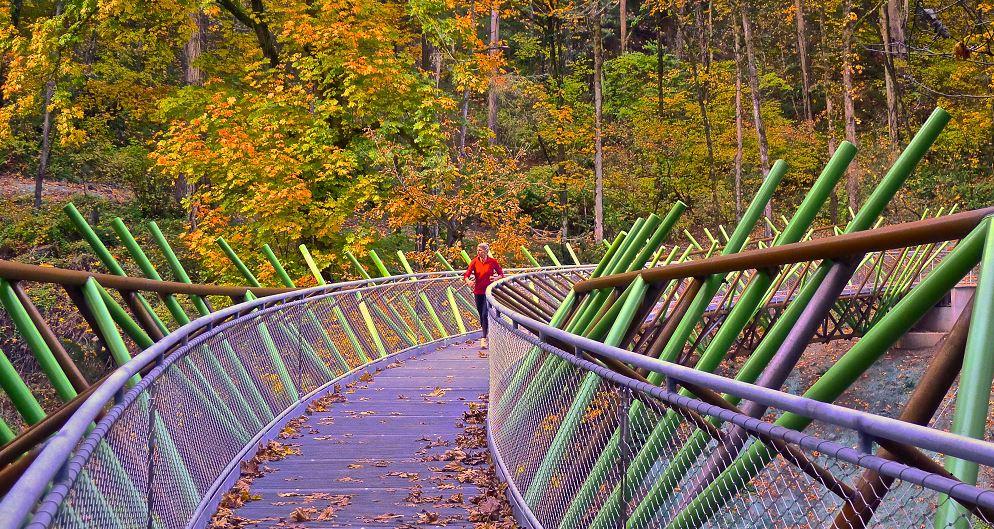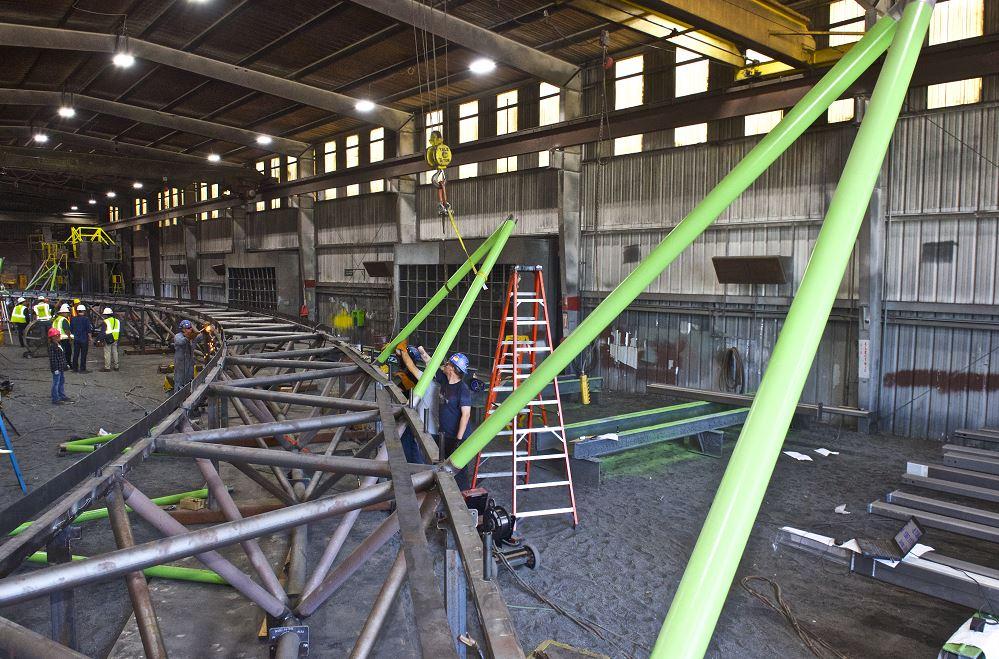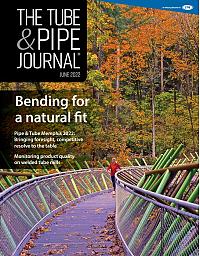Editor
- FMA
- The Fabricator
- FABTECH
- Canadian Metalworking
Categories
- Additive Manufacturing
- Aluminum Welding
- Arc Welding
- Assembly and Joining
- Automation and Robotics
- Bending and Forming
- Consumables
- Cutting and Weld Prep
- Electric Vehicles
- En Español
- Finishing
- Hydroforming
- Laser Cutting
- Laser Welding
- Machining
- Manufacturing Software
- Materials Handling
- Metals/Materials
- Oxyfuel Cutting
- Plasma Cutting
- Power Tools
- Punching and Other Holemaking
- Roll Forming
- Safety
- Sawing
- Shearing
- Shop Management
- Testing and Measuring
- Tube and Pipe Fabrication
- Tube and Pipe Production
- Waterjet Cutting
Industry Directory
Webcasts
Podcasts
FAB 40
Advertise
Subscribe
Account Login
Search
Structural pipe, tube creates natural fit for Portland footbridge
Tubular components, challenging angles give Barbara Walker Crossing Footbridge unique flair
- By Lincoln Brunner
- June 21, 2022
- Article
- Tube and Pipe Fabrication
When the Barbara Walker Crossing Footbridge was first conceived in 2012, its main function was to spare hikers and runners on Portland’s Wildwood Trail the bother of dodging traffic on heavily traveled West Burnside Road.
What it became was a testament to aesthetically minded architecture, blending utility and beauty for a community that prized (and demanded) both.
Elegant Complexity
The bridge, completed in October 2019 and dedicated that same month, is a 180-ft.-long pedestrian walkway that is curved in plan and designed to blend into the surrounding forest.
It was fabricated off-site by now-defunct Supreme Steel of Portland, cut into three main sections, and transported by truck to the site.
Meeting both the visual and architectural requirements meant using material that would accomplish all the project’s highly distinctive objectives, artistically and structurally. And that meant using pipe—in this case, 3.5- and 5-in. corten (ASTM A847) structural steel pipe, which is designed especially for structures that need to be welded or bolted. Some of the pipes are exposed (another key corten feature), and some are painted green to match the forest canopy.
Ed Carpenter, a designer and artist who specializes in large-scale public installations, said he had several objectives in mind when conceptualizing the bridge. Among them: The bridge should fit into the forest context, it should be a continuation of the feeling and experience of the trail, and it should be as delicate and transparent as possible.
That design necessitated a tri-chord truss to support the structure.
“Since one of my most important design objectives was to make the bridge delicate and transparent, I needed the most efficient materials possible and the most efficient structural system—so, the tri-chord truss,” said Carpenter, also an outdoors enthusiast who has run on Portland’s vast trail system for more than 40 years. “You could build that out of other materials, but steel tube or pipes was simply the logical choice.
From a practical construction point of view, achieving all of that was no small feat. Stuart Finney, a structural engineer at the Portland office of engineering firm KPFF who worked as project manager on the bridge, said that successfully welding all of the components at the T-Y-K connections, at which all the supporting pipes converge, proved to be perhaps the trickiest aspect of the entire endeavor. In particular, all the different angles requiring different types of welds (like fillet and groove) presented the construction team with a stiff challenge.
“Essentially every joint was different,” said Finney, who’s practiced his craft for 20 years. “They had to get every joint perfect so that all these pipes connected together at a single node and they could get sufficient weld around all the pipes.
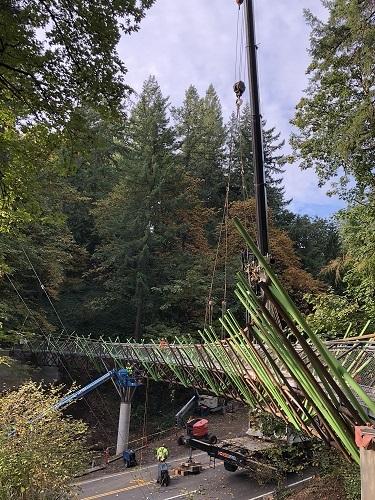
The Barbara Walker Crossing Footbridge spans Portland’s heavily traveled Burnside Road. It was dedicated in October 2019. Shane Bliss
“The weld had to get changed all the way around. The welding really was probably one of the most complex pieces of the fabrication.”
Community Passion, Community Project
The crossing’s namesake, Barbara Walker (1935-2014), was for many years a mainstay of natural preservation efforts in Portland and was a bit of a force of nature herself. She took an active role in myriad public projects in Portland, among them the Marquam Nature Park, Pioneer Courthouse Square, and the Powell Butte Nature Park. She also advocated tirelessly for what came to be known as the 40-Mile Loop, which includes the Wildwood Trail and the bridge.
Much like Walker did with raising about half a million dollars from the public ($15 per paving stone) for Pioneer Courthouse Square, the nonprofit Portland Parks Foundation raised $2.2 million from about 900 private donations to help fund the bridge. The city of Portland, Portland Parks & Recreation, and other entities contributed the rest of the of the roughly $4 million cost.
Carpenter said that juggling the many voices with a say in the project proved to be challenging—but well worth it.
“I think the overriding experience was of a great community collaboration and enormous pride and enormous participation—and people reaching deep into their pockets to support this,” Carpenter said. “And not only individuals, but also the city and the county. It was just a great group effort.”
Finney added that he and his team and the fabricators responsible for bringing the design to life had to overcome a lot of challenges in the 3D modeling that they did, simply because of all the intricacies of the joints and fittings.
“We were working with our detailers to make sure that all the models kind of lined up, because again, there was not room for error in a lot of these joints because the geometry was so complex,” Finney said. “It’s definitely on the more complex end than most. A lot of bridges are straight, and even the ones that are curved have curves with relatively simple materials.
“There were just a lot of little complexities that kind of came into the project just because of that. I’d say definitely it was more complex than regular [projects]. It was a lot of work for everyone to get the project to fruition.”
Of the key factors in the bridge’s complexity, however, it’s the curving deck that gives the bridge its overall effect, according to Carpenter. Did achieving that make it worth the trouble? By most accounts, yes.
“I think good design frequently starts with utility and then moves toward something more than that,” Carpenter said. “And that’s exactly what happened on this bridge. I think for me, the most important thing was the curving deck. I just couldn’t really feel good about a straight deck in this situation because the trail is so undulating and curving the entire way. I just didn’t want to make a hard left turn and get across a bridge and make another hard left turn and continue on.
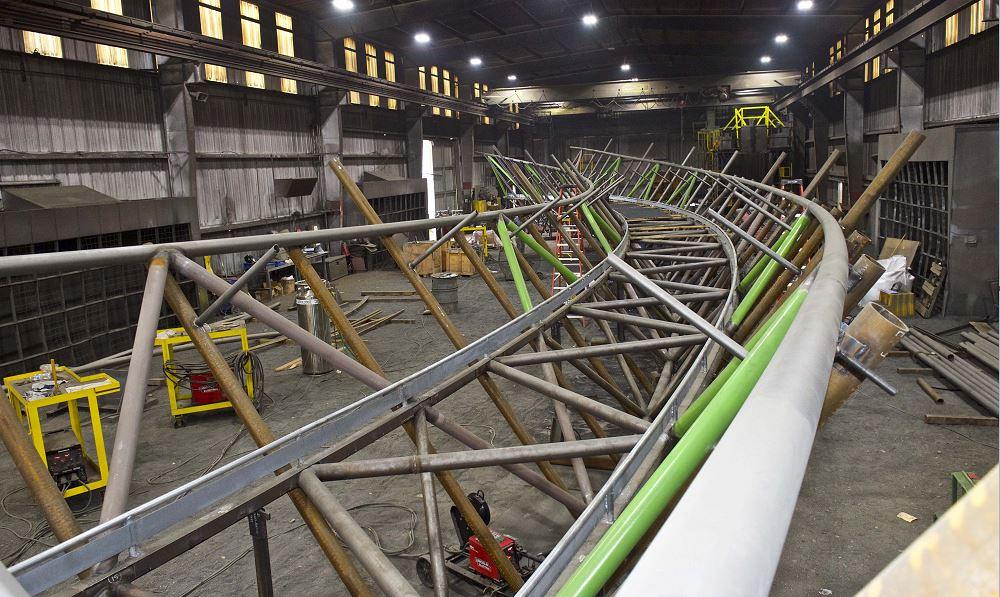
The Barbara Walker Crossing Footbridge was fabricated off-site, cut into two main sections, and trucked to its current location. Portland Parks Foundation
“How do you make a curving deck? Well, it turns out that, of course, a tri-chord truss is very efficient on the curve. You can get a depth-to-span ratio that’s very favorable. So, what can you do with a tri-chord truss to make it elegant and beautiful and to somehow refer to the forest in a way that makes it look as if it couldn’t be anywhere else? Starting with utility and then moving toward—what would be the word?—moving toward fancy. Or moving toward imagination from utility. Some people might do it in the reverse way, but it just happens to be that that’s the way I work.”
Carpenter credits KPFF staff in particular with giving him some of the inspiration he needed to project the pipes beyond the deck, which gives the bridge its organic, springing-from-the-forest feel. The project took about seven years from inception to grand opening, but Finney appreciates the opportunity to have worked on it.
“It’s nice to deliver something for the city and feel proud of it, but it was also nice to work on a neat engineering challenge, as well,” Finney said.
About 80,000 pedestrians will use the footbridge annually, according to the Portland Parks Foundation, saving them the trouble of crossing a section of road that sees about 20,000 vehicles daily.
Today the bridge serves to continue Walker’s vision of connecting residents and visitors in Portland with the beauty of the natural landscape around them.
“We need to provide urban people with an opportunity to access nature,” Walker (as quoted by the World Forestry Center) once said. “The excitement about nature comes from exposure to the outdoors. It can’t be learned in the abstract. By experiencing nature firsthand, people develop the urge to be stewards of the land.”
About the Author

Lincoln Brunner
2135 Point Blvd.
Elgin, IL 60123
(815)-227-8243
Lincoln Brunner is editor of The Tube & Pipe Journal. This is his second stint at TPJ, where he served as an editor for two years before helping launch thefabricator.com as FMA's first web content manager. After that very rewarding experience, he worked for 17 years as an international journalist and communications director in the nonprofit sector. He is a published author and has written extensively about all facets of the metal fabrication industry.
About the Publication
subscribe now

The Tube and Pipe Journal became the first magazine dedicated to serving the metal tube and pipe industry in 1990. Today, it remains the only North American publication devoted to this industry, and it has become the most trusted source of information for tube and pipe professionals.
start your free subscription- Stay connected from anywhere

Easily access valuable industry resources now with full access to the digital edition of The Fabricator.

Easily access valuable industry resources now with full access to the digital edition of The Welder.

Easily access valuable industry resources now with full access to the digital edition of The Tube and Pipe Journal.
- Podcasting
- Podcast:
- The Fabricator Podcast
- Published:
- 04/16/2024
- Running Time:
- 63:29
In this episode of The Fabricator Podcast, Caleb Chamberlain, co-founder and CEO of OSH Cut, discusses his company’s...
- Trending Articles
Zekelman Industries to invest $120 million in Arkansas expansion

3D laser tube cutting system available in 3, 4, or 5 kW

Corrosion-inhibiting coating can be peeled off after use

Brushless copper tubing cutter adjusts to ODs up to 2-1/8 in.

HGG Profiling Equipment names area sales manager

- Industry Events
16th Annual Safety Conference
- April 30 - May 1, 2024
- Elgin,
Pipe and Tube Conference
- May 21 - 22, 2024
- Omaha, NE
World-Class Roll Forming Workshop
- June 5 - 6, 2024
- Louisville, KY
Advanced Laser Application Workshop
- June 25 - 27, 2024
- Novi, MI
























